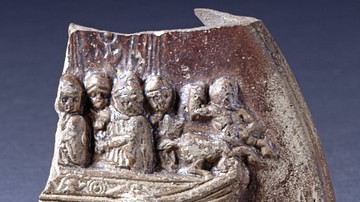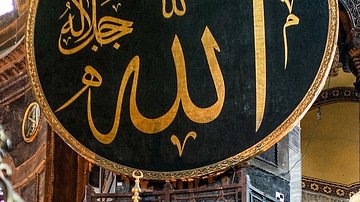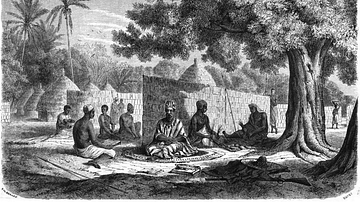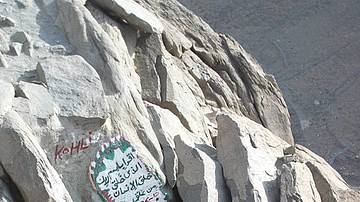Search Images
Browse Content (p. 811)

Image
Persepolis
Ruins of Persepolis.

Image
Roman Lamp Handle Ornament
Handle ornament broken from a terracotta lamp. It may commemorate Octavian's victory over Mark Antony and Cleopatra VII of Egypt at the Battle of Actium in 31 BCE. Possibly Italian, more probably Egyptian, fabric.

Image
Name of Allah in Arabic Calligraphy
A medallion with the phrase "Allah Jalla Jalaluhu" ("May His glory be glorified"), in Arabic calligraphy. The medallion was installed in the Hagia Sophia between 1847 and 1849 CE when the building was restored by Ottoman sultan Abdulmejid...

Image
Calligraphy of Abu Bakr
The vector version of the iconic calligraphy of the founder of the Rashidun Caliphate, Abu Bakr (c. 573 CE – 634 CE), which is prominent in the Hagia Sophia in Istanbul, Turkey.

Image
Wolof Chief & Residence
A mid-19th century CE illustration of a Wolof chief and residence. The Wolof Empire dominated West Africa between the Senegal and Gambia Rivers from the mid-14th to mid-16th century CE before breaking up into successor kingdoms, one of which...

Image
Maasai Herdsman
A herdsman of the Maasai people in northern Tanzania.

Image
Sunrise in the Maasai Mara
Sunrise in the Maasai Mara Game Reserve, Kenya.

Image
The Maasai of Ngorongoro
A group of Maasai people at Ngorongoro, Tanzania.

Image
Maasai Warriors
A group of Maasai warriors. The Maasai people have occupied East Africa, particularly southern Kenya and northern Tanzania since the 16th-17th century CE. (Photograph taken in 1973, Wereld Museum Collection, Rotterdam)

Image
Entrance to the Cave of Hira
The entrance to the Cave of Hira, a holy site for Muslims located in Jabal al-Nour, a mountain near Mecca. According to Islamic tradition, the Cave of Hira is where Prophet Muhammad received his first revelation in 610 CE.